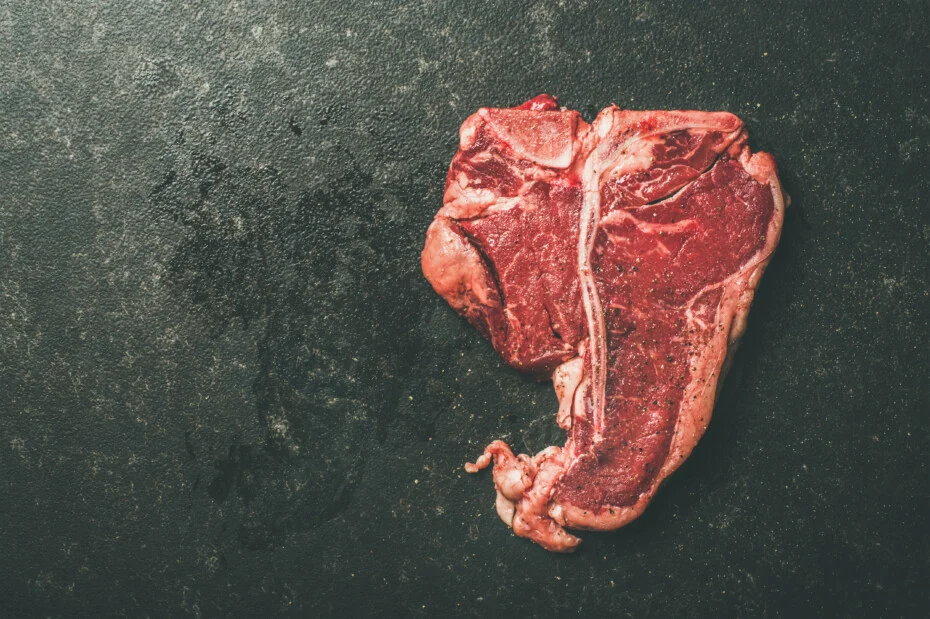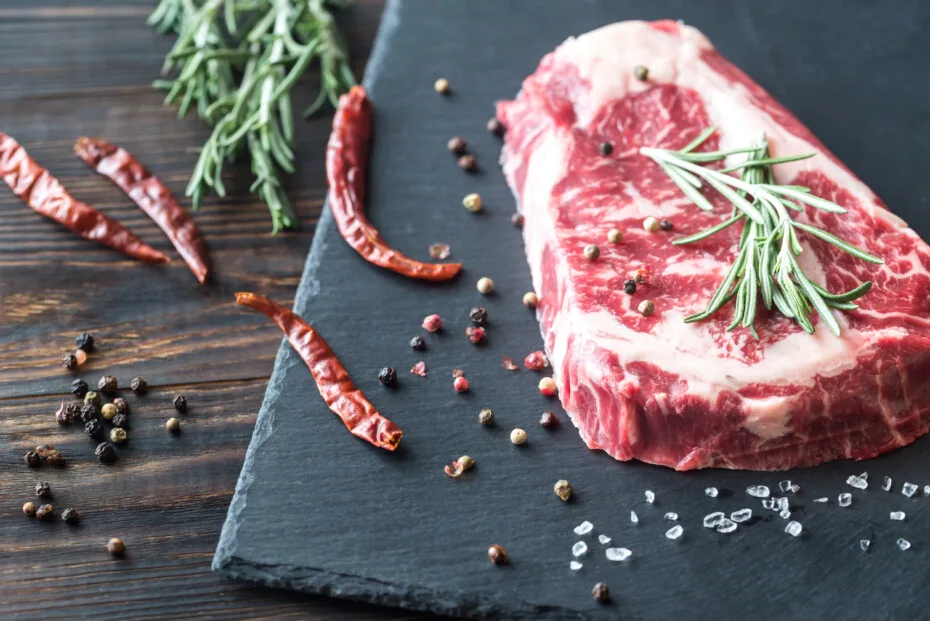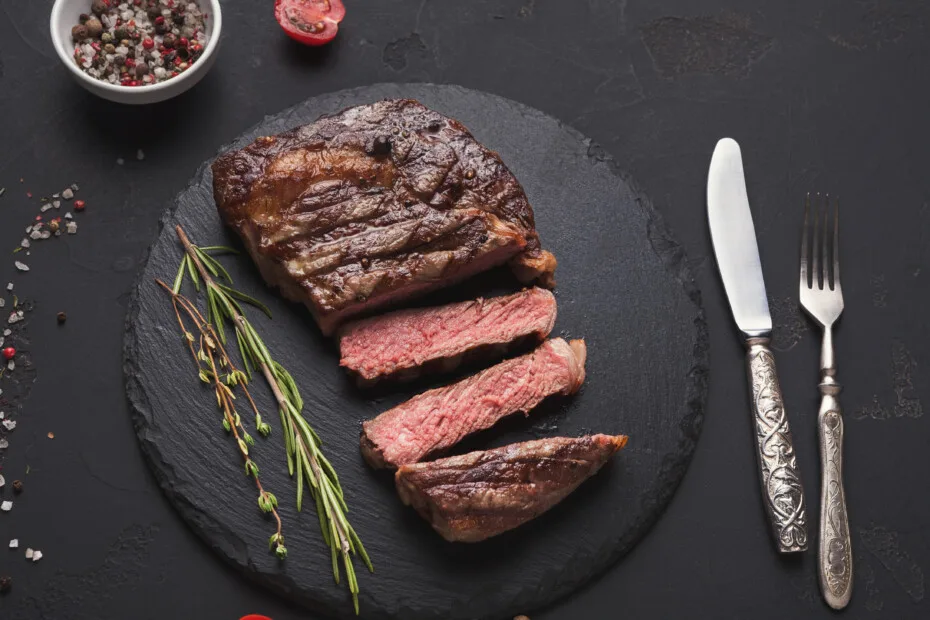It’s no surprise that steak enthusiasts are having an ongoing debate about which steak is the superior option.
However, which steak truly is the best option? Porterhouse or ribeye?
Given that there are strong views on both sides of the equation, we must compare and contrast before making any decisions.
Contents
- What Is Porterhouse Steak?
- How Is a Porterhouse Steak Different From a T-bone Steak?
- What Does Porterhouse Steak Taste Like?
- Where Should I Look For in a Porterhouse Steak
- What Is Rib-eye Steak?
- The Ribeye Muscles
- What Does a Ribeye Steak Taste Like?
- Porterhouse vs. Ribeye
- Differences in Appearance
- The Cost
- Cooking Variations
- Which Steak Is Superior: The Porterhouse or the Ribeye?
- Final Thoughts
What Is Porterhouse Steak?
A porterhouse steak is a combination steak originating from the position where the tenderloin and top loin converge.
In fact, if you debone a porterhouse steak, you would end up with segments of the tenderloin steak and top loin, also known as New York strip steak.

How Is a Porterhouse Steak Different From a T-bone Steak?
Technically a porterhouse is equivalent to a T-bone steak. It is a bigger version of the T-bone steak.
However, unlike the T-bone, porterhouse steaks are usually cut thicker and have a remarkably larger portion of the tenderloin.
The US Department of Agriculture defines a porterhouse steak as a steak with the filet portion that is a minimum of 1.25 inches in thickness from the bone to the broadest edge.
What Does Porterhouse Steak Taste Like?
Unlike other cuts of beef, the Porterhouse does not need to be dressed up to give you a delicious cut of meat. Instead, it gives you a double dose of the filet and the loin.
Although the less the filet tends to less flavorful than loin, it is definitely tender. The scoring resembles a strip steak and is loaded with beefy flavor.
Where Should I Look For in a Porterhouse Steak
When purchasing a porterhouse steak, select a steak that is at least 1.5 inches thick. Every so often on your grocery store runs, you may come across a thick steak; do not purchase it.
A true porterhouse has a sizeable amount of thickness which serves a purpose.
A perfectly cooked large steak has to have an impressive amount of mass and thickness.
A quality porterhouse steak has a deep, intense color free of gray with fat that is white and not yellow.
Select a steak with a healthy amount of marbling running throughout the meat, specifically in the loin segment.
One of the most crucial facts to know about porterhouse steaks is never to look for a discount. Dry-aged or prime-grade variants of the Porterhouse are costly.
Nevertheless, you should be able to obtain a quality choice-grade steak that packs a flavorful punch.
What Is Rib-eye Steak?
Ribeye steaks are usually prepared boneless or bone-in. Bone-in ribeye steaks contain a section of the rib bone exceeding the point of the ribeye muscle.
Boneless ribeye steaks are usually found in the meat aisle, while bone-in ribeye steaks are rare.
Bone-in steaks may be marked as rib steaks and are harder to prepare than their boneless counterparts.
The trouble with this cut of steak is that the meat flush against the bone cooks slower than the rest of the meat.
When this portion of the steak finally reaches medium-rare, the rest of the ribeye maybe medium or medium-well.
Nonetheless, the bone does contribute a significant amount of flavor and moisture.

The Ribeye Muscles
The primary muscle that makes up a ribeye steak is the longissimus dorsi. This long, tender muscle extends from the animal’s hip bone to the shoulder blade.
The longissimus dorsi is particularly tender because it is hardly worked.
Additionally, this muscle is also filled with a wholesome amount of intramuscular fat, which contributes moisture and flavor content of the steak.
The ribeye also has another muscle known as the spinalis dorsi, or ribeye cap. The ribeye cap is located at the top of the steak.
What Does a Ribeye Steak Taste Like?
Ribeye steaks are highly decorated with intramuscular fat. In fact, the ribeye’s beefy flavor is solely derived from the strip of fat between the longissimus from the spinalis dorsi.
For this reason, the ribeye is one of the most valued cuts of beef on the market.
The inner eye of meat has a super fine grain and presents a smooth texture upon chewing.
In contrast, the spinalis dorsi has a looser grain and contains more fat creating a tender, juicy cut of meat that melts like butter in your mouth.
Porterhouse vs. Ribeye
Although these two steaks are cut from the same animal portion, one cut originates from the upper portion of the ribs while the other steak originates in the lower ribs.
These steaks are not identical. Every cut of beef has its own unique flare.
The central differences between the Porterhouse and ribeye lie in the appearance, fat content, costs, and cooking methods.
Differences in Appearance
The easiest way to differentiate these two cuts of meat is simply by looking at them.
The ribeye steak is generally boneless, but bone-in ribeye usually has the bone running along the outward edge.
In contrast, the Porterhouse closely resembles a T-bone steak, with a bigger bone located in the middle of the meat. It is also significantly larger.
The Porterhouse may also be whole or sliced. Even an individual with a large appetite might find it difficult to finish this steak in one go.
Luckily one steak can feed two people making it the perfect meal for a romantic date night.
Fat Content
Another important distinction between Porterhouse vs. Ribeye is in the fat content.
But, again, fat levels can vary among these steaks depending on the location.
For example, a cut of beef located on the legs will be tough. The legs are always working. Thus, decreasing the levels of fat and guarantying a tough cut of meat.
On the other hand, a cut of meat located in the upper back portion of the animal, such as the tenderloin, will be extremely tender. Therefore, muscles of this nature are barely used and usually have a higher ratio of fat.
The location of Porterhouse and Ribeye directly affects the fat content. Ribeye steaks of known for their exquisite beefy flavor due to the high ratio of fat.
Porterhouse is known for having varying levels of tenderness encased in marbling on both sides.
The Cost
It is the common assumption that the price of Porterhouse and Ribeye steaks fluctuates greatly. However, these cuts are relatively the same price.
Depending on the size of the cut, ribeye’s usually run about $14-$15 a pound. However, bone-in ribeye’s are 1-2 dollars cheaper and average at about $13-$14 a pound.
Porterhouse steaks are generally prepared bone-in which lowers the price. Porterhouse steaks are cheaper than ribeye’s and usually cost about $12-$13 a pound.
Cooking Variations
All cuts of meat have different cooking times and methods. Ribeye’s are usually grilled, pan-fried, or broiled. These cooking methods yield the best results.
Pan-frying tends to be the most popular cooking method. Most people are intimidated by grilling over an open flame.
Droplets of melting fat responsible for the steak’s beautiful char drop down into the flame, causing it to flare up.
Grilling and broiling are by far the most popular method for cooking Porterhouse steaks. However, because of the Porterhouse’s shape and bone, it can be difficult to pan-fry.
Cooking times for porterhouse steaks are contingent upon the thickness of the porterhouse steak. A Porterhouse can take as long as 17 minutes or as little as 10 minutes.
Additionally, the center bone usually extends the cooking time by 5 minutes on each side, making it that much easier to overcook the steak.
The trick to cooking this monster of a steak is to flip it every few minutes once the initial sear has been completed. Porterhouse steaks can also be quickly smoked for 10-13 minutes.
When cooking a porterhouse or ribeye steak, the most important rule is to ensure you cook it to medium for maximum flavor and juiciness.
Your steak should have a temperature ranging between 135°F and 145°F.
If your steak is cooked to medium-well or well-done, you risk drying out the steak. No one can truly savor the taste of an overcooked steak.
Which Steak Is Superior: The Porterhouse or the Ribeye?
To be fair, both cuts of beef contain undeniable flavor. Furthermore, they are both suitable high-quality cuts of beef in the steak world.
Famished steak enthusiasts with a rather large appetite will deem the Porterhouse to be the champion of this battle.
On the other hand, steak lovers who enjoy savoring a juicy, tender dinner for one will deem the winner of this competition the ribeye steak.
Final Thoughts
Unfortunately, we’ve come to the end of our discussion. You have all of the information you need to know in regard to the differences between the porterhouse and ribeye steaks.
As for who reigns supreme, it’s time for you to weigh in on the conversation.
Best of all, you will get to cut into delicious cuts of beef and have all of your steak dreams fulfilled.
Why try one steak when you can have both!
You might also be interested in the following comparisons:
- Sirloin Vs. Ribeye
- Tomahawk Steak Vs. Ribeye
- Porterhouse Vs. T Bone
- Filet Mignon Vs. Ribeye
- Prime Rib Vs. Ribeye
- Tenderloin Vs Filet Mignon
- Sirloin Vs. Tenderloin
- Filet Mignon Vs. Sirloin
- New York Strip Vs. Ribeye
- T-Bone Vs. Ribeye Steak
- New York Strip Vs. Sirloin

I have been smoking and grilling meat from an early age and enjoy sharing my knowledge and expertise through the hundreds of articles I have written about BBQ. I hope to make everyone’s BBQ journey that little bit easier.

